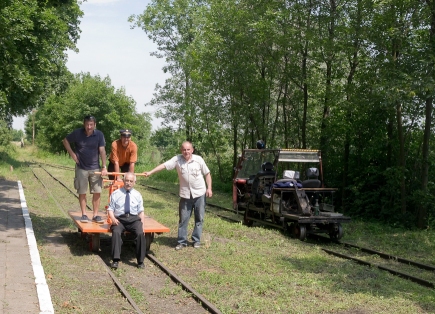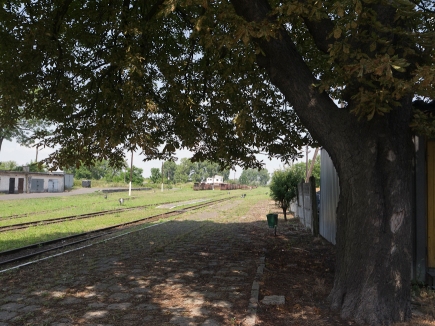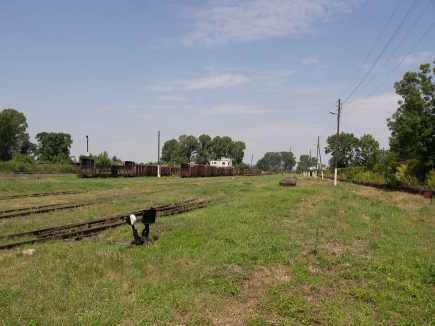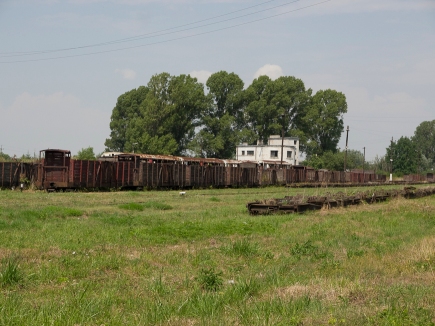With perhaps, the future of the daily ex Wolsztyn steam services being the one exception, no campaign has mobilised BTWT readers as much as the battle to save the Krosniewice Narrow Gauge Railway. Alas it seems that all our attempts – as well as the stalwart efforts of local enthusiasts – have failed to influence the decision makers.
As the various local authorities prepare to take over sections of the line, rip up the track and convert them into cycle paths, on July 6 our reporter paid a last nostalgic visit to photograph the railway’s remains at Ozorkow and Krosniewice.
The text and photographs in this article may be republished under the terms of the Creative Commons Attribution-NonCommercial-ShareAlike 4.0 International licence.
Volunteers tidy the path leading to the narrow gauge platform at Ozorkow. An Open Day is held each Sunday afternoon at the station. Photo (CC BY-NC-SA 4.0) BTWT.
(All photos can be expanded by double clicking on the images.)
In its heyday the Kujawy Narrow Gauge Railways – comprising some 1,000 km of 600mm and 750mm lines – were Poland’s largest narrow gauge network. Starting from various independent agricultural and sugar beet railways the lines were expanded and connected together into a 600mm network for the purposes of supplying the Prussian forces during WW I.
When Poland recovered its independence the ‘main line’ was converted to 750mm. PKP constructed two new buildings at Krosniewice in the latest Art Deco style – the station building and the running shed.
One of the attractions of the Sunday Open Days is the possibility of a ride on a platelayer’s trolley. Local volunteers pose with an itinerant Englishman. Photo (CC BY-NC-SA 4.0) BTWT.
The Kujawy Railways survived WWW II and some of the remaining 600mm feeder lines were converted to 750mm gauge. At the start of 1991, PKP reorganised the Kujawy Narrow Gauge Railways into three independent railways the Gniezno Narrow Gauge Railway, the Sompolno Narrow Gauge Railway, and the Krosniewice Narrow Gauge Railway.
The Krosniewice Railway and the Gniezno Railway – but not the Sompolno Railway – were two of the some two dozen railways that were rescued from the wholesale destruction of the remaining PKP narrow gauge lines in 2001.
Thanks to co-operation between the then Mayor of Krosniewice, and the former PKP general manager of the line, the Town Council decided to acquire the Krosniewice line from PKP.
At first sight Krosniewice station appears to be open. Closer inspection reveals to two changes wrought by Barbara Herman, the Mayor of Krosniewice – the removal of the level crossing barriers across the main road, and the grave-like display of flowers in the platelayer’s trolley next to the level crossing. Photo (CC BY-NC-SA 4.0) BTWT.
While the legal formalities for the transfer of the ownership of the line proceeded, the Council obtained an operating licence from PKP SA granted which it sub-licensed to SKPL, a society set up with the objective of carrying on operations on the recently closed narrow gauge railways.
The line’s future seemed secure. SKPL operated a regular passenger service on weekdays linking Krosniewice to the PKP stations at Ostrowy and Krzewie. On market days the service was extended to Dabrowice and Wielka Wies Kujawska.
But the main work on the line was freight – carrying supplies to and refined sugar from sugar refineries situated on the network. At the peak of SKPL operations the line was carrying 100,000 tonnes of freight a year.
Looking to the North – everything appears neat and tidy. Photo (CC BY-NC-SA 4.0) BTWT.
The legal wheels turned but slowly – Polish law required PKP to recreate the missing deeds for all the parcels of land over which the line ran before a formal handover could be concluded with Krosniewice Council.
Meanwhile, as a gesture of good faith, PKP transferred the ownership of all the line’s rolling stock – including a working Px48 steam locomotive – to the Council.
Unlike PKP, SKPL received no central government subsidy. During the off-season it was sometimes difficult to find the money to purchase replacement parts for the diesel locomotives and pay staff.
Slowly, disused feeder lines began to vanish… .
But a peek across the wall shows that every piece of glass is smashed in the skylight of the workshop roof. Photo BTWT.
Meanwhile a group of railway enthusiasts started clearing the overgrown trackbed on the disused track bed between Ozorkow and Krosniewice. While senior SKPL management – based in the Zbiersk Cukrownia HQ of the Kalisz narrow gauge railway – backed their efforts, relations with management and staff at Krosniewice were strained.
Perhaps the greatest achievement of local railway enthusiasts was when GDDKiA (Poland’s Directorate of Trunk Roads and Motorways) decided that they needed to take over a section of the narrow gauge railway in the vicinity of Topola Krolewska to build a new wide viaduct across the Lodz-Kutno railway line. Thanks to the energetic lobbying of the enthusiasts, the GDDKiA ended up having to construct a brand new viaduct for the narrow gauge line as well!
The narrow gauge freight wagons have received no attention since the line’s closure. Photo (CC BY-NC-SA 4.0) BTWT.
In 2006, at special meeting in Ozorkow the supporters of the line decided to formally constitute themselves into the Kujawy Narrow Gauge Railways Society. SKPL Chairman, Tomasz Strapagiel, attended the meeting and gave the venture his support.
The Society acquired a passenger coach from the defunct Piotrkow Trybunalski narrow gauge railway and restored it to running order. The Society’s volunteers cleared the trackbed from Krzewie to Ozorkow and, with the co-operation of SKPL, a number of special trains – which proved very popular – were run through to Ozorkow.
The Art Deco building in the background is the running shed. Photo (CC BY-NC-SA 4.0) BTWT.
Then in 2007 or thereabouts a new Mayor was elected in Krosniewice. Whereas the previous Mayor saw the Krosniewice Railway primarily as a transport undertaking, the new Mayor – Barbara Herman – saw the railway as a lucrative development opportunity.
Soon she visited the line, in the company of the local PKP property surveyor, and expressed an interest in demolishing the historic workshop buildings in order to make was for a major new property development – the General Wladyslaw Anders Centre.
Recently repainted, the point lever and indicator adds a surreal touch. Photo (CC BY-NC-SA 4.0) BTWT.
Mrs Herman requested that SKPL vacate the workshop buildings. The General Manager pointed out that SKPL needed the workshops to maintain the transporter wagons used to carry the standard gauge freight wagons. The Mayor countered that she had no interest in carrying ant freight though she might be prepared to countenance a small ‘fun fair railway’ somewhere on the site.
SKPL refused to vacate the workshop buildings. The Mayor countered by terminating SKPL’s licence to operate the railway.
These coal trucks have a special compartment for a brakeman and were last used on sugar beet trains. Photo (CC BY-NC-SA 4.0) BTWT.
The last train ran on 31 March, 2008. Ironically SKPL were in negotiation with a bulk aggregate supplier to deliver several hundred tonnes of roadstone required for building the A2 and A1 motorways. Ads a result of the Mayor’s decision roads in the Lodz Province were subject to tens of thousands of tonne km of unnecessary road traffic.
The Mayor’s decision provoked a massive storm of protest. Realising which way the wind was blowing, the Mayor trimmed her sails maintaining a public stance that she supported the reopening of the railway. She even allowed local activists to organise a couple of special trains from Krosniewice to Ozorkow to demonstrate her good intentions. Meanwhile, behind the scenes, the Mayor continued her attempts to have the workshop buildings demolished.
Barely visible under the undergrowth – a line of standard gauge transporter wagons. Photo (CC BY-NC-SA 4.0) BTWT.
But the Mayor’s plans hit an unexpected obstacle in the form of the Wojewodzki Konserwator Zabytkow, Mr Wojciech Szygendowski. Mr Szygendowski refused to grant permission to have the historic listed buildings demolished.
With her plans apparently thwarted the Mayor decided to reverse her predecessor’s decision to acquire the whole of the Krsoniewice Narrow Gauge Railway from PKP. Instead she came up with the plan that each local council should acquire just that section of line that lay within the its own administrative boundaries.
Now the demise of the railway could become a collective affair – one council could use the line for a cycle path, another for road improvements… and as the line died section by section and the historic workshop buildings deteriorated she could try yet again to have them demolished.
The low buildings were the machine shops. The smashed windows and doors tell their own story. Photo (CC BY-NC-SA 4.0) BTWT.
Without any maintenance, the workshop buildings deteriorate year by year. Unless a ‘white knight’ appears on the scene it seems increasingly like that Mrs Barbara Herman will succeed in her plan to bring about the final end of the Krosniewice Railway.
Further reading:
- BTWT – archive about the Krosniewice Railway
- Local volunteers – Facebook pages and photos
- BTWT – photos of Krosniewice taken in 2010
- IPTLODZ – 2004 article (Polish text many photos)











Leave a comment